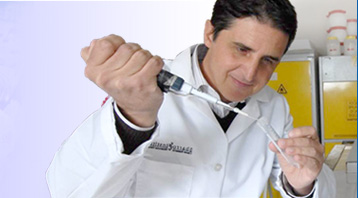 |
||
 |
The research in this laboratory aims to better understand the biology of HBV and HCV e.g. pathogenesis of hepatitis B and hepatitis C virus associated hepatocellular carcinoma. |
 |
|
BIOGRAPHY DETAILS
Mark Feitelson, Ph.D. Professor of Biology, and Associate Director, Center for Biotechnology, Temple University (USA) and Director of the Hepatitis and Liver Cancer Program at S.H.R.O attended Cypress College (Cypress, CA) from 1970-72, and then received a B.S. degree in biology from the University of California, Irvine in 1974. He received a Ph.D. in Microbiology and Immunology from the UCLA School of Medicine in 1979. His thesis presented the genetic organization of the rabbit papilloma virus. He was then an American Cancer Society postdoctoral fellow in the Department of Medicine at Stanford University from 1980-1982, where he started his work with hepatitis B virus (HBV). Dr. Feitelson was then recruited to the Fox Chase Cancer Center by Dr. Baruch Blumberg (who won the Nobel Prize for his discovery of HBV) where he continued his work in HBV. In 1988, Dr. Feitelson became an independent faculty member at the Fox Chase Cancer Center at the rank of Associate Member. In 1991, Dr. Feitelson was recruited as an Associate Professor in the Department of Pathology, Anatomy and Cell Biology at Thomas Jefferson University, and from 1997-2007 was a full-professor in the same department. He also held a secondary appointment in the Department of Microbiology and Immunology within the Kimmel Cancer Center at Jefferson. During this time, Dr. Feitelson ran a CAP certified clinical molecular diagnostic lab in microbiology for Thomas Jefferson University Hospital. Dr. Feitelson is presently Professor of Biology at Temple University and Associate Director of the Temple Biotechnology Center. He has been consistently funded by NIH and foundations since 1988 for basic science work on HBV and has attracted 10 contracts from industry for translational and applied work since 1997. Dr. Feitelson has over 100 publications in highly ranked international scientific journals, has written two books; delivered more than 160 oral presentations and/or posters at national and international scientific meetings, and has delivered more than 100 invited lectureships all over the world. In 2003, Dr. Feitelson was a visiting professor at the Center for the Study of Liver Diseases at Hong Kong University, and since then, has been named visiting professor at Fudan University (Shanghai), Guangzhou University (Guangzhou), as well as at the Second and Fourth Military Medical Universities (Shanghai and Xian, respectively) in China, where he promotes U.S./Chinese collaborations in the field of hepatitis B. Dr. Feitelson has recently been named outstanding alumnus of Cypress College. He has also served on NIH study sections, reviews manuscripts for many journals, and has mentored many students at the graduate and undergraduate levels. He is also involved in commercializing his basic science discoveries over the past 20 years in both Europe and the Far East, where hepatitis B infections and associated liver diseases are prevalent. Dr. Feitelson currently holds membership in the following scientific societies: American Association for the Advancement of Science (AAAS), American Society for Virology (ASV), New York Academy of Sciences (NYAS), American Society for Investigative Pathology (ASIP), Federation of American Societies for Experimental Biology (FASEB), American Association for Cancer Research (AACR), Association for Molecular Pathology (AMP), American Society for Microbiology (ASM)-Eastern Pennsylvania Branch and National. |
||||||
| |
||||||
PUBLICATIONS |
|
TOP | CONTACT | SALUTE-HEALTH | DONATE | LINKS |
|
© Copyright 2003 - 2010, Sbarro Health Research Organization,All rights reserved. |

 Mark Feitelson, Ph.D.
Mark Feitelson, Ph.D.